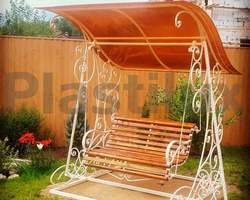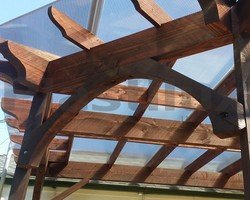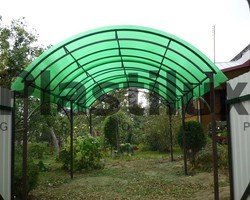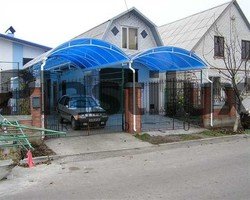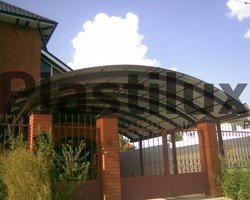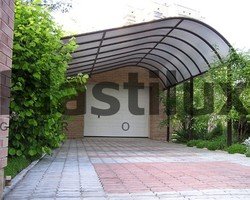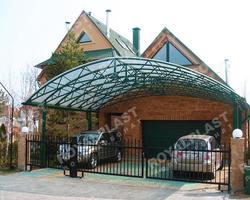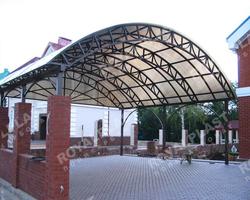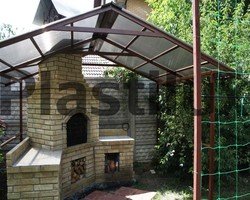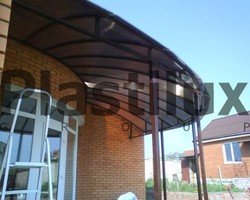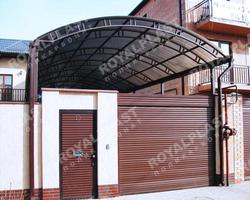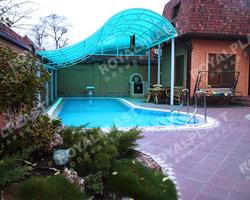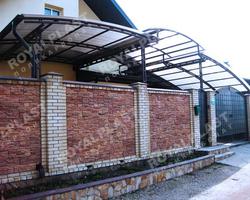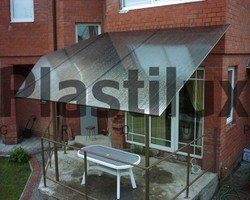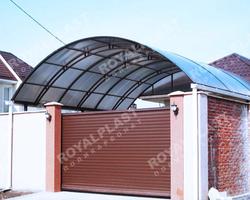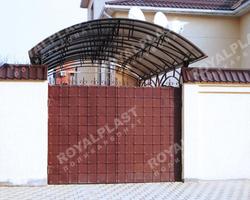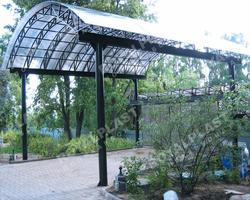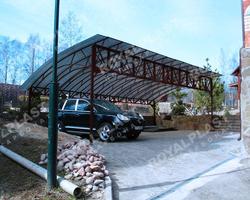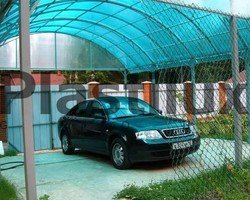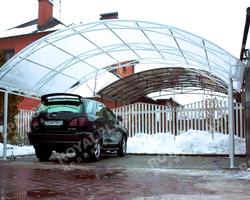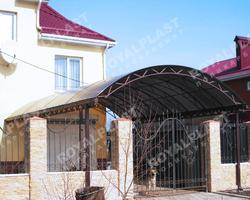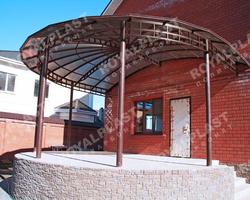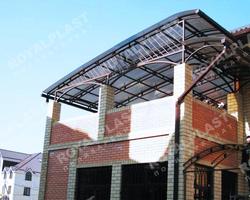Ваша машина под надёжной защитой
Владельцы автомобилей знают, как важно обеспечить безопасное и практичное место для его стоянки.
Для защиты машины многие автовладельцы используют навесы, поскольку они:
- ✔ компактны;
- ✔ легко монтируются;
- ✔ не требуют колоссальных финансовых затрат;
- ✔ не ограничивают и не «съедают» открытую придомовую территорию.
Конструкции, по сути, являются альтернативой громоздким гаражам, но в отличие от них имеют достаточно открытого пространства для удобства подхода к автомобилю с любой стороны.
Для изготовления защитной конструкции используют дерево или любой листовой кровельный материал – шифер, профнастил, но на пике популярности стоит полимеризированный карбонат. Навес под машину из поликарбоната отличается прочностью, долговечностью, возможностью вариаций форм и цветов.
Выбор места для монтажа
К будущей парковке выдвигается ряд требований, площадка должна:
- ✔ быть просторной для вмещения автотранспортного средства;
- ✔ иметь удобный подход и въезд;
- ✔ не нарушать имеющийся ландшафт.
В качестве локации для монтажа навеса для автомобиля из поликарбоната зачастую выступает:
- ✔ выезд со двора;
- ✔ территория, примыкающая к гаражу;
- ✔ площадь на границе участка со стороны проезжей части.
Универсальными параметрами парковочной территории для одного автомобиля считается 3,5x6 м, для стоянки двух машин – 5,5x6 м.
Виды конструкций
По своему принципу строения конструкция навеса для автомобиля из поликарбоната примитивна и состоит из трех базовых элементов:
- 1. Платформы, в качестве которой может выступать площадка, залитая бетоном, закатанная асфальтом, застланная брусчаткой или вибропрессованной плиткой толщиной 60 мм.
- 2. Вертикально ориентированные несущие опоры для надежности и прочности тента.
- 3. Крыша, которая выступает ключевым элементом навеса и предохраняет автомобиль от непогоды и прямых солнечных лучей.
Напольное покрытие для навеса должно соответствовать следующим параметрам:
- • иметь высокую стойкость к истиранию;
- • обладать механической прочностью;
- • быть устойчивым к воздействию горюче-смазочных и химически активных веществ;
- • иметь высокий коэффициент сцепления с резиной автомобильных шин;
- • гармонировать с окружающим ландшафтным дизайном.
Основой стоек для навесов может выступить металлический профиль, деревянный брус и даже каменные, кирпичные или бетонные стойки. Все зависит от общей стилистической концепции двора.
Форма для поликарбонатной крыши для машины в силу особенностей кровельного материала может быть любая:
- • пологая;
- • односкатная;
- • двускатная;
- • арочная;
- • волнообразная;
- • сферическая.
Наиболее практичным вариантом считаются скатные и арочные кровли. Они не позволяют снегу и мусору скапливаться на конструкции и выглядят презентабельно.
При строительстве крытого парковочного места зачастую используется два типа сооружения:
- 1. Автономный – характеризуется наличием металлических столбов, расположенных в двух параллельно ведущих рядах, и каркаса крыши, устланной поликарбонатными плитами. По геометрии крыша может быть – односкатной, двухскатной, куполообразной, арочной.
- 2. Примыкающий – подразумевает взаимодействие с внешней стеной дома или гаража, которая выступает в качестве опорной конструкции. Параллельно ей монтируются металлические опоры. Актуально формирование односкатной или слегка закругленной крыши.
Выбор типа сооружения основывается на местоположении объекта, эстетических характеристиках и практических функциях.
Свойства поликарбоната
Для полного осознания всех преимуществ навеса для машины на дачу из поликарбоната следует подробнее ознакомиться с материальной базой тентового элемента сооружения. Используемый для крыши полимеризированный карбонат – термопластик, производимый посредством экструзии бесцветных гранул, имеет широкий спектр эксплуатационных свойств, которые выгодно отличают его от альтернативных строительных материалов.
Благодаря пластичности прозрачный материал податлив формовке и колоризации, что позволяет производителям варьировать его цветовую гамму, расширяя ассортиментный ряд продукции и увеличивая рыночный спрос.
По своей структуре материал может быть:
- • монолитный – литой профилированный материал с высокой светопропускной способностью;
- • сотовый – многослойное ударопрочное изделие с внутренними пустотами, заполненными продольными перемычками.
Востребованность поликарбоната обусловлена его модернизированными эксплуатационными качествами:
- • прозрачность – пропускает до 83% солнечного света, защищает от УФ-излучений;
- • легкость – на 35% легче стекла аналогичной толщины;
- • долговечность – гарантированный срок службы минимум 8-20 лет;
- • гибкость при термическом воздействии;
- • экологичность – отсутствие выделений в окружающую среду вредных веществ;
- • гигиеничность – податливость механической обработке с воздействием абразивных моющих средств;
- • низкая теплопроводность благодаря пустотелости;
- • ударная стойкость 2-4 Дж, в 200 раз прочнее стекла.
Поликарбонат для навесов относится к разряду негорючих, самозатухающих материалов класса горючести Г1. Он не впитывает и не пропускает влагу, устойчив к грибковым образованиям и имеет антибактериальную поверхность. Подходит для внутренней отделки и внешних работ.
Особенности расчета и возведения
При самостоятельном монтаже следует учитывать специфику этого кровельного материала и его линейные размеры. Производители выпускают стандартные плоскости шириной 2,1м при вариациях длины 6 м и 12 м для сотовых изделий и 1,15x2 м для профилированного поликарбоната.
При расчете расхода материала рекомендуем ознакомиться с базовыми правилами:
- 1. Шаг для стропил должен быть кратным ширине материала: для 2,1 м – 1050 мм и 700 мм, для 1,15 м – 575 мм и 383 мм.
- 2. Место стыковки оформляется стыковочным профилем, ширина которого 20 мм.
Размещение стыковочного профиля осуществляется не вплотную к пластику, а с зазором в 3 мм с каждой стороны. Это связано со значительным температурным расширением материала.
Для достижения оптимальной нагрузки на каркас конструкции стропила и прогоны размещают в одной плоскости на расстоянии не менее 400 мм. Минимальный угол наклона кровли 6°, при этом, чем круче угол наклона, тем дальше друг от друга располагаются прогоны, вплоть до 1 м. Опорные профили забивают в грунт на глубину 1400 мм.
Технология монтажа
Процесс возведения навеса для автомобиля из поликарбоната своими руками производится по установленному алгоритму:
- 1. Оформление парковочной площадки.
- 2. Бетонирование опорных столбов. При закладке плиточного напольного покрытия заливка несущих опор производится отдельно, при бетонировании пола – в процессе заливки площадки.
- 3. Закрепление столбов к основанию бетона анкерными болтами.
- 4. Изготовление металлоконструкции для крыши. Для арочного варианта возможен заказ каркаса в специализированных компаниях или при наличии трубогиба – самостоятельно. Односкатная крыша подразумевает изготовление сварной металлоконструкции с продольными и поперечными балками, один ряд из которых ниже противоположного на 30-40 см.
- 5. Оклейка термолентой металлических плоскостей, контактирующих с поликарбонатом.
- 6. Установка коньковых и стыковочных профилей, соединение их с металлом саморезами с пресс-шайбами по разметке.
- 7. Раскрой листа по длине.
- 8. Очищение места реза от пыли и стружки, оклейка торцов (8-10 см от края) защитной лентой для предотвращения попадания влаги в каналы.
- 9. Укладка поликарбонатных панелей в сконструированные профилями направляющие, их фиксация шурупами с термошайбами.
- 10. Перфорация свободного края сверлом 2 мм с целью надежности закрепления торцевых профилей.
- 11. Снятие защитной пленки с поликарбонатной крыши.
Для монтажа поликарбонатного навеса потребуется закупка следующих материалов:
- ✔ несущий скелет крыши (арочный, односкатный, двускатный);
- ✔ квадратный профиль для обрешетки (40x20 мм);
- ✔ квадратный профиль для прогонов (60x40 мм или 60x60 мм);
- ✔ опорный профиль квадратного сечения (60x60 мм, 80x80 мм, 100x100 мм);
- ✔ смесь для бетонирования;
- ✔ материал напольного покрытия;
- ✔ пресс-шайбы;
- ✔ саморезы с оцинкованным покрытием;
- ✔ анкерные болты;
- ✔ поликарбонат толщиной не менее 10 мм.
Также для работы стоит заранее подготовить инструменты:
- ✔ рулетку;
- ✔ угольник;
- ✔ электролобзик;
- ✔ ключи;
- ✔ шуруповерт;
- ✔ молоток;
- ✔ наждачную бумагу.
Соблюдение заданных размеров заранее подготовленной на бумаге схемы расположения конструктивных узлов каркаса позволит обеспечить надежность и устойчивость конструкции в целом.
Где заказать поликарбонат
Приобретать плиты из полимеризированного карбоната для монтажа навеса лучше у проверенных поставщиков, в числе которых официальный интернет-магазин завода по изготовлению сотового поликарбоната и поликарбонатных профилей ПЛАТИЛЮКС-ГРУПП.
Здесь можно подобрать материалы на любой вкус, отличающиеся:
- • строением (моноплиты, сотовые изделия);
- • оттенком (от светопропускающих прозрачных до блокирующих солнечное излучение цветных вариантов);
- • толщиной (для сотовой продукции – 4 мм, 6 мм, 8 мм и 10 мм изделия, монолитный шифер представлен в толщине 0,8 мм).
Доступны следующие марки поликарбоната, характеризующиеся индивидуальными особенностями и различным эксплуатационным периодом:
- • ROYALPLAST – плотный пластик с двухсторонней УФ-защитой и удельным весом 0,83-1,4 кг/м², срок гарантии 20 лет;
- • POLYNEX – негорючий ударопрочный пластик плотностью 0,94-1,3 кг/м², гарантия качества до 15 лет;
- • SUNNEX – полимер среднего ценового диапазона плотностью 0,59-1,25 кг/м², гарантия до 12 лет;
- • ULTRAMARIN – вариант эконом-класса с удельным весом 0,55-0,99 кг/м² и гарантией от производителя до 10 лет.
В нашем интернет-магазине можно купить также вспомогательные пластиковые изделия для качественного и надежного монтажа навесов для машины – соединительные профили (4 мм, 6 мм, 8 мм, 10 мм), торцевые профили (4 мм, 6 мм, 8 мм, 10 мм), термошайбы.
Возникли вопросы по реализуемой продукции, ее доставке и оплате или сложности в оформлении заказа – обратитесь к менеджерам компании по телефону или задайте свой вопрос в онлайн-чате.
